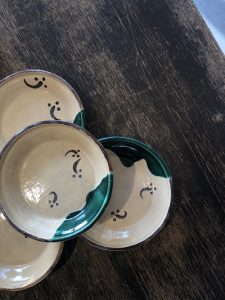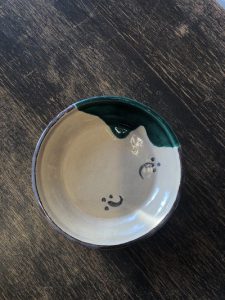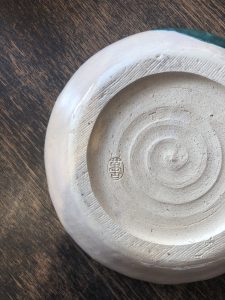三重県の菰野町へ立ち寄ってまいりました。(愛知県名古屋市千種区姫池通 骨董買取いたします 古美術風光舎名古屋店)
2022.03.13
こんにちは、スタッフYでございます。

先日、まだ訪れてたことのなかった三重県菰野町のアクアイグニスへ行って参りました。
ご存じない方に少しお伝えいたしますと、アクアイグニスは三重県菰野町に2017年に誕生した『癒し』と『食』をテーマにした複合温泉リゾート施設でございます。敷地面積約49,000㎡(14,848坪)の中に、都内でも有名なパティシエやシェフが一斉にスイーツや石窯パン・イタリアン・和食などのお店を出店。地元の食材なども生かした食事などが楽しめたり、源泉100%掛け流しの片岡温泉・宿泊棟・離れ宿・そしていちごハウス等が集結し、日帰りでもご宿泊でも存分に楽しめるスポットとなっております。そして背後には鈴鹿山系が聳え、その雄しい山々を望みながらのドライブにて訪れるというなんとも、アクセスまでのロケーションも充実したリゾート施設であります。
そんなアクアイグニス、タイミングが合わず行く機会を逸していたのですが、ふと温泉に行ってみたいと趣味のドライブを兼ねてふらりと訪れてみましたが、そちらのアクアイグニス内にございます片岡温泉がですね…大変良かったです。
熱湯の湯気がちょっと苦手なわたくしは、どちらかというと半身浴でゆっくりと入りたい派。そんなゆっくりと半身浴したい方には丁度良いお湯でありました。
お湯は地下1200mより湯口で丁度42℃前後の源泉を毎分780ℓ、加水・加温・循環せずにシャワーも含め贅沢にかけ流し。泉質であるアルカリ性単純温泉により美肌効果ありだそうです。たしかに、肌がスベスベでした。
それもそのはず、科学的にも不要な角質をとり“ツルツル肌”をつくる効果や毛穴の汚れをとったりメラニンを分解したりすることによる“美肌効果”が認められているそうです。
そんな理想的なお湯ではあるのですが、入る前に「最近、長湯のため倒れるお客様がおりますので、長湯にご注意ください。」との注意書きが目に留まりました。泉質・温度共に私の理想的なお湯のせいでしょうか、この私でさえ快適が過ぎて長く浸っておりましたので、温泉にいかれる方はくれぐれもご注意を笑。
とまあ目的は温泉へ行くことだったのですが、ここ菰野町はですね、そう、みんな持ってる土鍋の名産地であります。そう、萬古焼です。
萬古焼は、現在三重県四日市市と菰野町を中心に生産されている焼き物でございまして、萬古焼には細かくさまざまな名称があるのですが、なかでも「四日市萬古焼」は、1979年に国の伝統工芸品に指定されます。
その特徴とは、まず分類として「半磁器」に分けられる点。半磁器の萬古焼は、非常に硬く丈夫で耐水性が高いのも大きな特徴といえるでしょう。また萬古焼は、釉薬を使用しません。つまり、素材そのものの色を活かした器作りをしているという特徴があります。その色味は、紫色(小豆色)をしており、紫泥焼きと呼ばれることも。
その萬古焼の歴史は、江戸時代中期に桑名の豪商・茶人であった沼波弄山(ぬなみろうざん)が始めたとのこと。この頃の沼波家は「萬古屋」という陶器の廻船問屋を営んでおり、弄山は幼少期から茶道に触れ、商人と茶人という二つの顔を持っていたようであります。
そんな弄山、茶道の趣味が高じて朝日町小向に開窯したことが始まりだったようでして、非常に教養のある人物であり、京焼の技法を元にさまざまな作品を作り出します。
弄山が亡くなり萬古焼は一時中断しましたが、江戸時代後期になり森有節が復活させております。それは、古萬古の雰囲気を再現した焼き物でしたが、だんだんと独自の表現を見出し、やがて流行。煎茶が流行しつつあったのはこの時期でもあり、有節は煎茶急須を研究し木型による急須を誕生させます。
この急須は非常に薄い作りであり、内側に龍の陰刻がされた急須でして、さらにピンク色の釉薬の開発や華やかな色絵が施された急須は西洋でも評判になり、明治時代にはパリ万博や京都博覧会などへ出品され、多くの賞を受賞し高い評価を受けたようです。
その頃桑名周辺地域では「桑名萬古」と呼ばれる有節萬古に似た焼き物が多くつくられますが、これは明治維新後、商業の中心地となった四日市で作られる萬古焼に吸収されていくことになります。
そして現代に残る「四日市萬古」は山中忠左衛門が、水害の被害を受けた地区住民の救済のために窯をつくったことが始まりとのこと。それから四日市萬古は、どんどん産業として発展しますが明治時代中期になると原料の白土が採れなくなり停滞していきます。そこで赤土を使ったろくろ引きの紫泥急須が生み出され、四日市萬古焼の主力製品となっていきます。
そんな紆余曲折を経て、1978年四日市萬古焼急須は、国から伝統的工芸品に指定に。同じく三重県で生産されます伊勢茶と萬古焼急須との組み合わせは抜群でして、萬古焼の生産地域の周りはお茶畑も広がっており、同じ土では育まれたもの同士相性も抜群といったところでしょうか。
また1911年には、水谷寅次郎が磁器土と陶土を合わせた半磁器の開発に成功。下絵付けの発色が良く土の温かみが感じられ、さらに大物をつくることができるこの半磁器は、開発した翌年に大正時代となったことを記念し「大正焼」と名付けられますが、半磁器の開発により萬古焼の器は全国的に需要が増え、有数の陶磁器産地になり、昭和後期に入ると、耐熱性を上げる技術も進み、そこでできた土鍋は国内生産量日本一になっていきます。
そう、それが皆様ご存じの土鍋であります。現在では、国内のシェア80~90%近くを占めているほどですので、萬古焼を確かめたい方はすぐにご家庭のキッチンへ向かってください笑。
萬古焼を含め、焼き物もこうして紆余曲折を経て生き延びているのかと思いますと、土鍋や急須として現代に生き残っている姿がだんだん進化の最先端に見えてきてきました。

とまぁ、萬古焼のことを少しご理解いただけたと思いますが、肝心の萬古焼、どんな焼き物かと申しますと特別な装飾や技法など特に決まった型のものはございません。「萬古の印があることがいちばんの特徴」と言われるほど形や色はさまざまで、自由な発想のもと、ものづくりが行われている焼き物です。成形方法もさまざまで、水ゴテ・排泥鋳込み・型萬古などたくさんあり、焼成も土の種類によって焼き方を変えています。
店舗にも明治~大正時代の萬古焼がございますが、自由さが特徴の萬古焼と申し上げた通り、こちらの中皿もいたって自由なデザイン。もちろんお皿の裏には、ちゃんと「萬古」が入っております。

そしてこちらのお皿、明治~大正時代ということですから現代の萬古焼の進化途中でありましょうか。このお皿ができた頃、ここから土鍋や急須に進化し、日本中のキッチンに鎮座することとなろうとは、まだ知る由もございませんね笑。
それでは、ごきげんよう。
Hello, this is Staff Y.
The other day, I went to Aqua Ignis in Komono Town, Mie Prefecture, which I hadn’t visited yet.
For those who don’t know, Aqua Ignis is a complex hot spring resort facility with the theme of “healing” and “food” that was born in 2017 in Komono Town, Mie Prefecture. Famous pastry chefs and chefs in Tokyo have opened shops for sweets, stone oven bread, Italian food, Japanese food, etc. all at once in the site area of about 49,000 m2 (14,848 tsubo). You can enjoy meals that make use of local ingredients, and the Kataoka Onsen, accommodation building, inn, and strawberry house, which are 100% sourced from the source, are gathered together, making it a spot that you can fully enjoy on a day trip or overnight stay. increase. And the Suzuka Mountains tower in the background, and you can visit by driving while looking at the majestic mountains, which is a resort facility with a good location to access.
I missed the opportunity to go to Aqua Ignis because of the timing, but I suddenly wanted to go to a hot spring, so I visited it as a hobby drive, but Kataoka Onsen in that Aqua Ignis. But … it was very good.
I’m not good at steaming hot water, but I’d rather take a half-body bath and take a leisurely bath. It was just the right hot water for those who want to take a half-body bath slowly.
Hot water is 780 liters per minute from a source of just around 42 ° C at the sprue from 1200 m underground, and it is luxuriously poured including a shower without adding water, heating, or circulating. It is said that the alkaline simple hot spring, which is a spring quality, has a beautiful skin effect. Certainly, my skin was smooth.
That should be the case, and it seems that the effect of removing dead skin cells that are scientifically unnecessary to create “smooth skin” and the “skin-beautifying effect” of removing dirt from pores and decomposing melanin are recognized.
It is such an ideal hot water, but before I entered it, I noticed a note saying, “Recently, some customers have fallen down because of the long hot water, so please be careful about the long hot water.” Perhaps it’s because of my ideal hot spring quality and temperature, even I was so comfortable that I was soaked for a long time, so please be careful if you go to the hot springs.
Well, the purpose was to go to a hot spring, but here in Komono-cho, yes, it’s a famous clay pot production area that everyone has. Yes, it’s Banko ware.
Banko ware is currently produced mainly in Yokkaichi City and Komono Town, Mie Prefecture, and there are various detailed names for Banko ware. Among them, “Yokkaichi Banko ware” was created in 1979. It is designated as a national traditional craft.
The characteristic of Banko ware is that it can be classified into “semi-porcelain”. Banko ware made of semi-porcelain is extremely hard, durable and highly water resistant. Banko ware does not use glaze.
In other words, it has the characteristic of making vessels that make use of the color of the material itself.
Its color is purple (reddish color), and it is also called purple mud grilled.
The history of Banko ware was started by Rouzan Nunami, a master tea master of Kuwana in the middle of the Edo period. Running a wholesaler, Nunami has been exposed to the tea ceremony since childhood and seems to have had two faces, a merchant and a tea master.
It seems that the kiln was opened in Obuke, Asahi-cho because of his high taste for tea, and he is a very well-educated person who creates various works based on the technique of Kyo ware.
Banko ware was temporarily suspended due to the death of Rouzan Nunami, but Yuusetsu Mori has revived it in the latter half of the Edo period. It was a pottery that reproduced the atmosphere of Komanko, but gradually it became popular after discovering its own expression, but at this time when sencha was becoming popular, Yusetsu studied sencha teapots and made teapots with wooden patterns. I will give birth.
This is a very thin teapot with a dragon inscription on the inside, and the development of pink glaze and the gorgeous color painting of the teapot became popular in the West, and in the Meiji era It was exhibited at the Paris Expo and the Kyoto Expo, and it seems that it received many awards and received high praise. At that time, many pottery similar to Arisetsu Banko called “Kuwana Banko” was made in the area around Kuwana, but this was absorbed by Banko ware made in Yokkaichi, which became the center of commerce after the Meiji Restoration. Will be.
The “Yokkaichi Banko” is said to have started when Tadashiemon Yamanaka built a kiln to help the residents of the area affected by the flood. After that, Yokkaichi Banko steadily developed as an industry, but in the middle of the Meiji era, the raw material white clay could not be obtained and it stagnated, but there was a rokurobiki purple teapot using red clay, and Yokkaichi Banko ware was produced. Will become the main product of.
And Yokkaichi Banko ware teapot, which was designated as a traditional craft by the country in 1978. The combination of Ise tea, which is also produced in Mie Prefecture, and Banko ware teapots is excellent, and there are tea fields around the production area of Banko ware, and the ones grown in the same soil are also excellently compatible with each other. Shall we?
In 1911, Torajiro Mizutani succeeded in developing a semi-porcelain that combines porcelain clay and porcelain clay. This semi-porcelain, which has a good underpainting color and feels the warmth of the soil, and can make even bigger ones, is named “Taisho ware” to commemorate the Taisho era the year after its development. With the development of Banko ware, the demand for Banko ware has increased nationwide, and it has become one of the leading porcelain producing areas. Yes, the clay pot you all know. At present, it has a domestic market share of nearly 80-90%.
I wonder if pottery has survived through twists and turns along with history, and the appearance of surviving as clay pots and teapots in modern times has gradually become at the forefront of evolution.
Banko ware does not have any special decorations or techniques.
There are so many different shapes and colors that it is said that “the most characteristic is the presence of Banko ware”, and it is a pottery that is manufactured based on free ideas. There are various molding methods, such as water iron, mud casting, and mold manko, and the firing method is different depending on the type of soil.
The store also has Banko ware from the Meiji to Taisho era, and as I said, Banko ware is characterized by its freedom, this middle plate is also a free design. Of course, “Manko” is properly contained on the back of the plate.
Since it is a plate from the Meiji to Taisho era, is it in the middle of the evolution of modern Banko ware? I don’t know yet that this plate will evolve into a clay pot or teapot from here lol.
Well then, good luck.
**********************
三月にはいりました。
暖かくなり、また新しい年度に向けてお片付けをはじめられた方もいらっしゃるのではないでしょうか。
生活様式の変化とともに、大切なお品を整理されている方も多いことと思われます。
ここ古美術風光舎では、古美術品や骨董品の他にも絵画や宝石、趣味のお品など様々なジャンルのものを買受しております。
お片付けをされていて、こういうものでもいいのかしらと迷われているものでも、どうぞお気軽にご相談下さいませ。
古美術風光舎は、出張買取も強化しております。
愛知県内はもちろん、岐阜県・三重県その他の県へも出張いたします。
どんなにご近所の方でもお伺いできますので、まずはお電話お待ちしております。
愛知県名古屋市千種区・骨董 買取
『古美術 風光舎 名古屋店』
TEL 052(734)8444
10:00-17:00 OPEN

